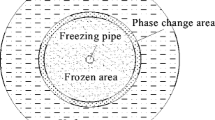Abstract
For embankments in permafrost regions, the soil properties and the upper boundary conditions are stochastic because of complex geological processes and changeable atmospheric environment. These stochastic parameters lead to the fact that conventional deterministic temperature field of embankment become stochastic. In order to estimate the influence of stochastic parameters on random temperature field for embankment in permafrost regions, a series of simulated tests are conducted in this study. We consider the soil properties as random fields and the upper boundary conditions as stochastic processes. Taking the variability of each stochastic parameter into account individually or concurrently, the corresponding random temperature fields are investigated by Neumann stochastic finite element method. The results show that both of the standard deviation under the embankment and the boundary increase with time when considering the stochastic effect of soil properties and boundary conditions. Stochastic boundary conditions and soil properties play a different role in random temperature field of embankment at different times. Each stochastic parameter has a different effect on random temperature field. These results can improve our understanding of the influence of stochastic parameters on random temperature field for embankment in permafrost regions.










Similar content being viewed by others
References
Zhou YW, Guo DX, Qiu GQ (2000) Geocryology in China. Science Press, Beijing (in Chinese)
Mu S (1988) Numerical analysis of temperature field in a thawing embankment in permafrost. Can Geotech J 25(1):163–166
Zhang MY, Lai YM, Liu ZQ, Gao ZH (2005) Nonlinear analysis for the cooling effect of Qinghai–Tibetan railway embankment with different structures in permafrost regions. Cold Reg Sci Technol 42(3):237–249
Zhang MY, Lai YM, Dong YH (2009) Numerical study on temperature characteristics of expressway embankment with crushed-rock revetment and ventilated ducts in warm permafrost regions. Cold Reg Sci Technol 59(1):19–24
Lai YM, Zhang LX, Zhang SJ, Mi L (2003) Cooling effect of ripped-stone embankments on Qing–Tibet railway under climatic warming. Chin Sci Bull 48(6):598–604
Liu ZQ, Lai YM (2005) Numerical analysis for the ventilated embankment with thermal insulation layer in Qing–Tibetan railway. Cold Reg Sci Technol 42(3):177–184
Lai YM, Wang QS, Niu FJ, Zhang KH (2004) Three-dimensional nonlinear analysis for temperature characteristic of ventilated embankment in permafrost region. Cold Reg Sci Technol 38(1):165–184
Lai YM, Zhang MY, Liu ZQ, Yu WB (2006) Numerical analysis for cooling effect of open boundary ripped-rock embankment on Qinghai–Tibetan railway. Sci China Ser D Earth Sci 49(7):764–772
Vanmarcke E, Shinozuka M, Nakagiri S, Schueller GI, Grigoriu M (1986) Random fields and stochastic finite elements. Struct Saf 3(3–4):143–166
Soulie M, Montes P, Silvestri V (1990) Modelling spatial variability of soil parameters. Can Geotech J 27(5):617–630
Ramly HE, Morgenstern NR, Cruden DM (2002) Probabilistic slope stability analysis for practice. Can Geotech J 39(3):665–683
Elkateb T, Chalaturnyk R, Robertson PK (2003) An overview of soil heterogeneity: quantification and implications on geotechnical field problems. Can Geotech J 40(1):1–15
Hasselmann K (1976) Stochastic climate models part I. Theory. Tellus 28(6):473–485
Majda AJ, Timofeyev I, Eijnden EV (1999) Models for stochastic climate prediction. Proc Natl Acad Sci 96(26):14687–14691
Majda AJ, Timofeyev I, Eijnden EV (2001) A mathematical framework for stochastic climate models. Commun Pure Appl Math 54(8):891–974
Liu ZQ, Lai YM, Zhang XF, Zhang MY (2006) Random temperature fields of embankment in cold regions. Cold Reg Sci Technol 45(2):76–82
Liu ZQ, Lai YM, Zhang MY, Zhang XF (2007) Numerical analysis for random temperature fields of embankment in cold regions. Sci China Ser D Earth Sci 50(3):404–410
Liu ZQ, Yang WH, Wei J (2014) Analysis of random temperature field for freeway with wide subgrade in cold regions. Cold Reg Sci Technol 106–107:22–27
Wang T, Zhou GQ, Wang JZ (2015) Stochastic analysis model of uncertain temperature characteristics for embankment in warm permafrost regions. Cold Reg Sci Technol 109:43–52
Bonacina C, Comini G, Fasano A, Primicerio M (1973) Numerical solution of phase-change problems. Int J Heat Mass Transf 16(10):1825–1832
Lewis RW, Morgan K, Thomas HR (1996) The finite element method in heat transfer analysis. Wiley, New York
Qin DH (2002) The comprehensive evaluating report on the environment evolvement in West China. Science Press, Beijing (in Chinese)
Wang T, Zhou GQ, Yin QY (2014) Local average method of triangular elements for discretization of the random filed of geotechnical parameters. Rock Soil Mech 35(5):1482–1488 (in Chinese)
Wang T, Zhou GQ (2013) Neumann stochastic finite element method for calculating temperature field of frozen soil based on random field theory. Sciences in Cold and Arid Regions 5(4):488–497
Yamazaki F, Shinozuka M, Dasgupta G (1988) Neumann expansion for stochastic finite element analysis. J Eng Mech 114(8):1335–1354
Wu ZW, Cheng GD, Zhu LN (1988) Roadbed engineering in permafrost regions. Lanzhou University Press, Lanzhou
Cheng GD, Jiang H, Wang KL (2003) Thawing index and freezing index on the embankment surface in permafrost regions. J Glaciol Geocryol 25(6):603–607
Zhu H, Zhang LM (2013) Characterizing geotechnical anisotropic spatial variations using random field theory. Can Geotech J 50(7):723–773
Acknowledgments
This research was supported by the Major State Basic Research Development Program (Grant No. 2012CB026103), the China Postdoctoral Science Foundation funded project (Grant No. 2016M591958), the National Natural Science Foundation of China (Grant No. 41271096) and the 111 Project (Grant No. B14021). We express our sincere thanks to the two reviewers for their valuable comments and suggestions on the content of the paper.
Author information
Authors and Affiliations
Corresponding author
Rights and permissions
About this article
Cite this article
Wang, T., Zhou, G., Wang, J. et al. Estimation on the influence of uncertain parameters on stochastic thermal regime of embankment in permafrost regions. Heat Mass Transfer 53, 1113–1122 (2017). https://doi.org/10.1007/s00231-016-1883-5
Received:
Accepted:
Published:
Issue Date:
DOI: https://doi.org/10.1007/s00231-016-1883-5




